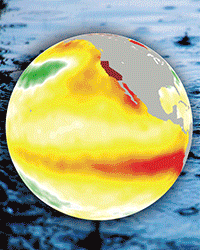Atmospher Sci & Global Chg
Research Highlights
October 2015
California, Here We Come: Floods and Drought
Pacific Ocean patterns fueled by climate warming may launch more extreme weather

Weather patterns called El Niño and La Niña may combine with climate warming which could lead to at least a doubling of extreme floods and droughts in California later this century. El Niño is the “wet” phase (in orange) and La Niña is the “dry” phase (in blue). Image courtesy of the authors. Refresh page to restart animation.
Results: After a season of wildfires, Californians are begging for rain to end the drought. But a lesson in "be careful what you ask for" might be in store for the Golden State. Researchers at Pacific Northwest National Laboratory have found that the weather patterns known as El Niño and La Niña could lead to at least a doubling of extreme floods and droughts in California later this century. The study, simulating historical and future climate outcomes, was published in the online journal Nature Communications.
"Wet and dry years in California are linked to El Niño and La Niña. That relationship is getting stronger," said atmospheric scientist Dr. Jin-Ho Yoon at PNNL. "Our study shows that ENSO [see sidebar, ENSO] will be exhibiting increasing control over California weather."
Why it Matters: California is experiencing one of the most severe droughts in its history, but it's not clear if a warmer world will make droughts worse, more frequent or perhaps even improve the situation. After all, warmer air can hold more water, and some research suggests global warming could increase California's average rain and snowfall. Using global climate models is a way that scientists can size up climate outcomes using inputs of historical measurements and estimates of future conditions, depending on whether greenhouse gases are held steady, increase, or decline.
Methods: Current research suggests future rain will come down more as light drizzles and heavy deluges and less as moderate rainfall. Yoon and colleagues from PNNL and Utah State University in Logan, Utah, wondered if droughts might follow a similar pattern. Looking at what happens to California in global climate models, they simulated two periods of time: 1920 to 2005 using historical measurements; and 2006 to 2080 using conditions in which very few efforts are made to reduce greenhouse gas emissions.
The models showed that in the future, assuming emissions continue to increase, California seasons will exhibit more excessively wet and excessively dry events. These results suggest that the frequency of droughts could double and floods could triple between the early 20th century and late 21st century.
"By 2100, we see more and more extreme events. Flooding and droughts will be more severe than they are currently," said Yoon.
What's Next? Scientists only know El Niño and La Niña years are on their way by measuring sea surface temperatures and other weather hints. Future studies of these weather phenomena may help scientists understand how these systems combine with other climate influences to affect extreme events.
For more information, see the PNNL news release, California 2100: more frequent and more severe droughts and floods likely
Acknowledgements
Sponsor: The research was supported by the U.S. Department of Energy (DOE) Office of Science Biological and Environmental Research for the Earth System Modeling program.
Research Team: Jin-Ho Yoon, Ben Kravitz, and Philip J. Rasch, PNNL; S-Y Simon Wang, Robert R. Gillies, and Lawrence Hipps, Utah Climate Center at Utah State University.
Research Area: Climate & Earth System Science
Reference: Yoon JH, SY Wang, RR Gillies, B Kravitz, L Hipps, and PJ Rasch. 2015. "Increasing Water Cycle Extremes in California and Relation to ENSO Cycle under Global Warming." Nature Communications 6:8657. October 21, 2015. DOI: 10.1038/ncomms9657
